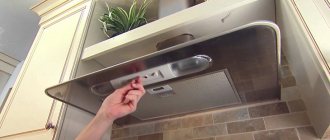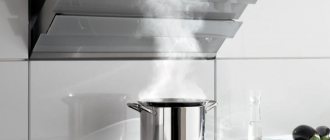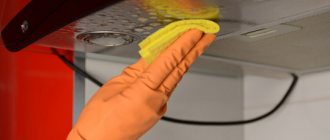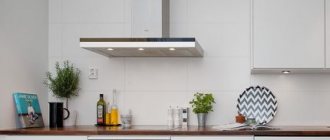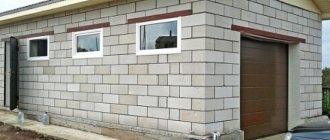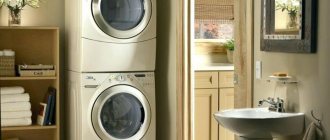Despite the availability of various semi-finished products, pizzas or hamburgers, and full meals delivered to your home, many Russian housewives still prefer to pamper themselves and their family with homemade dishes. And representatives of the stronger sex quite often come to the stove, not trusting store-bought food or wanting to surprise their family with a truly masculine culinary masterpiece. And for some, cooking and the art of cooking is a favorite hobby or profession.
Of course, during the cooking process on the stove, appetizing and not-so-appetizing odors appear. Hot fumes and greasy soot spread throughout the kitchen and throughout the house. To prevent negative consequences, experts give a clear answer: install the hood immediately, at the stage of installing the kitchen unit. But is this really necessary? Is it really impossible to do without a hood? Or can you rely on good natural, forced ventilation in the kitchen? Let us examine this issue in more detail, assessing the advantages and disadvantages of installing this unit.
Hood for domestic needs in the kitchen
This is a device designed to purify the air in the kitchen from gas combustion products, water vapor, small particles of soot and fat. That is, the whole bouquet that pollutes the air and the entire room during the heat treatment of products. It is purchased and installed separately from kitchen units, at the request of the homeowners. What are its features?
- The basis of the design consists of a body made of various materials - glass, plastic, metal. Dimensions, shape and colors depend on the installed design.
- The housing houses a motor that drives the fan. Its power varies, since devices are produced for both tiny and spacious rooms.
- Drawn in by the fan, polluted air passes through a system of carbon filters, or is discharged into the ventilation system and further into the street.
Thanks to these devices, the air in the kitchen is forcibly purified in a short time. If you turn them on at the very beginning of the cooking process, the vapors and soot simply do not have a chance to spread throughout the entire room.
Tips for use
- Keep the device clean and wipe it free of dust and grease after each use.
- Do not turn off the device immediately after cooking, as steam particles can spread throughout the kitchen faster than the device can absorb them. Therefore, you need to leave the hood running for a few more minutes so that it draws in all the fumes.
- Replace carbon filters regularly - at least 2 times a year.
Diverter kitchen hoods
This class of exhaust devices is connected to the building’s ventilation system, or to pipelines leading through the wall to the street. Taking the air saturated with vapors from inside the room, they remove it outside through a filter on which soot remains. It is believed that such devices purify the air better and faster. But they also have disadvantages:
- not all houses have a ventilation system and it is not always possible to connect to it;
- pipes, even those chosen in color and shape, spoil the appearance of the kitchen and take up precious meters of space;
- installation is more difficult than for compact pendant systems.
To properly install and connect a tap-off model, experience or a hired specialist is required.
Requirements for air ducts and electrical networks
Parameters such as air ducts and electrical networks directly affect the performance of exhaust devices. That is why it is necessary to take a responsible approach to the design of ventilation ducts and electrical networks.
It should be immediately noted that for recirculation type hoods there is no need to lay ventilation pipes. They absorb air and simply filter it, after which they return it back to the room. That is why this chapter will consider the flow-through type of exhaust equipment.
If you do not plan the air exhaust system correctly, a person may get a number of the following problems:
- Changes in pressure in the channels;
- Load on the hood motor;
- Poor air permeability;
- Large air flow from the street.
To avoid this, it is best to use the help of professionals who will install ventilation ducts according to GOST standards. Only in this case will the hood be able to reveal its full potential and not cause problems during long-term use.
Also, attention must be paid to electrical networks. The position of the socket must correspond to the length of the factory hood cable. Under no circumstances is it recommended to extend the equipment wire yourself; this can lead to cable oxidation and overloading the hood.
The socket is also installed in accordance with GOST standards. It is best to plan the wiring and power points in advance after the hood has already been purchased. Of course, you can always use an extension cord.
Where to put the socket
So, in order to correctly design and install ventilation ducts, it is necessary to adhere to the basic opinions of experts, which will help increase the performance of the hood and reduce the pressure on the device’s motor.
The first thing to avoid when laying communications is excessive bends. First of all, they force the exhaust air to create additional pressure in order to deliver the exhaust air outside the house. Hence the conclusion: the fewer knees, the less force the device will need to expend to perform its basic functions. Also, the pipes must be sealed. Under no circumstances should holes be allowed in them, which could lead to a loss of pressure and, accordingly, to overload of the hood motor.
It is important to make the distance from the hood to the street as short as possible so that the exhaust device spends less energy working with a large volume of air. Also, narrowing and expansion should be avoided - the pipe must be of the same cross-section throughout its entire length, which will allow maintaining constant pressure for normal operation of the fans.
It is also recommended to install ventilation communications strictly at level. There is no need to make the air rise at an angle through the pipe; it is better to maintain a strict horizontal line and use a 90-degree elbow to move to the vertical level.
The diameter of the ventilation pipes must match the hood connector. It is best to use pipes made of environmentally friendly plastic or galvanized, they will last longer, and the cost will not hit the budget too much.
It is important to note that the installation of ventilation ducts should be carried out by a specialist who has extensive experience working with hoods and knows the basic subtleties that can improve or, conversely, worsen the performance of the exhaust device.
Distance for ventilation ducts
According to GOST standards, the outlet for the exhaust device is installed at a height of 2.5 meters from the floor level. This is the optimal indicator that specialists will use during the installation of electrical communications.
Also, it is necessary to step back 15-20 centimeters to the left or right from the hood so that the equipment body does not block the access point to the electrical network. Some hoods are connected directly to the network using terminal blocks or plugs, so installing an outlet is not always necessary.
It is very important to provide grounding for the outlet. Grounding prevents the device from burning out due to voltage surges or other unpleasant situations. Considering that some hoods cost a lot of money, it is best to take every precaution and know that the equipment will not be damaged.
If the wiring and sockets are old and the hood is already installed, you can use an extension cord. However, it is recommended to purchase an extension cord with a fuse (a device that will disconnect the carrier from the mains in the event of power surges or other situations).
Recirculating kitchen hoods
Circulation systems do not have air ducts. The dirty air supplied inside passes through a filter system, is cleaned, and then discharged back into the kitchen. That is, the same air circulates in the room, without access to fresh air from outside. Therefore, the kitchen must be ventilated from time to time, otherwise the concentration of carbon dioxide may exceed reasonable limits. In addition, such devices often cannot cope with rich odors and combustion products of household gas from a gas stove.
They also have advantages:
- compact dimensions;
- the ability to install under cabinets, in countertops, on walls;
- ease of installation.
This type of hood can be installed independently if you carefully follow the attached instructions.
Criterias of choice
In order of importance, the criteria for choosing a kitchen hood for a gas stove can be ranked as follows:
- kind of work;
- dimensions and configuration;
- technical characteristics - power, control, additional functions.
We recommend that you read: Find out everything about the distance from the stove to the hood
Kind of work
For a gas stove, a hood that removes gases from the room is preferable to a recirculation model.
Dimensions and configuration
These two parameters should be determined to the nearest centimeter. For a gas stove, a hinged hood is recommended, the area of which is slightly larger than the width of the stove. The minimum acceptable size is when the dimensions are the same.
We determine the configuration of the equipment according to the capabilities of the room and furniture. The dome model will require free space above the burners up to the ceiling. A built-in option or a pull-out model will fit well into wall cabinets.
Specifications
The operating power of a household hood is measured in watts and indicates the capabilities of the motor. When choosing, you should be interested not so much in the power itself, but in the productivity associated with it (measured in cubic meters per hour).
Power calculation
The performance required for your kitchen is calculated using the formula:
kitchen area (m²) × wall height (m) × 12 = minimum possible performance in air exhaust mode in cubic m/h
where 12 is the recommended number of complete air renewal cycles
The power of the selected kitchen hood for a gas stove must exceed the result obtained by 1.3.
Note! When operating in recirculation mode, power drops by at least 25%.
Controls and additional functions
Manufacturers offer several types of control for household hoods - touch, push-button, slider, remote, with the possibility of automatic modes. It is quite difficult to recommend one type of control or another. Here the choice depends on taste and preference.
Slider control (using a moving slider) is considered the most convenient for older people. Buttons are the most reliable option. Touch panel - for a stylish kitchen and a young housewife.
Additional functions include the type of backlight, filter contamination indicator, timer, response to human presence, the presence of a screen, and the ability to connect to a computer.
We recommend reading: How to choose an island hood for your kitchen
Dome kitchen hoods
The hoods of this model have an original canopy in the form of a dome, in which the engine, filters and all the necessary mechanics are located. Due to their interesting appearance, the devices are called “fireplace”. They are often used as an expressive decorative element. The only negative is the large dimensions.
General information about the model
This ingenious integrated kitchen appliance fits perfectly into a modern cooking work area and matches any furniture. The design of this device will not leave anyone indifferent, and every time you prepare dishes you can get aesthetic pleasure.
As you can see from the photo, this model has excellent design and looks very stylish and modern.
The hob is equipped with four induction burners and is complemented by all sorts of useful functions. The surface of the device is covered with smooth, wear-resistant glass ceramics. This material is easy to clean from dirt and can withstand heavy loads.
The grille air vent cover is located in the central zone of the cooking device and rises 10 mm above the glass-ceramic surface.
General control of the stove and hood is carried out by a convenient touch panel with a clear indication. The operation of the hood can be adjusted either separately or together with the induction surface in a combined mode.
The device can be installed on the working surface of furniture in the standard way - with the panel supported on the tabletop, or it can be installed flush with the tabletop, in a milled groove 6.5 mm deep.
Hood or ventilation in the kitchen?
The debate over the need for hoods in the kitchen continues. People defend diametrically opposed opinions. Some people claim that it is impossible to live and create in the kitchen without it. But for some, this unit is a waste of money, since high-quality ventilation provides the necessary air exchange, and in extreme cases there are vents and transoms.
To understand whether the kitchen really cannot be done without an exhaust hood, it’s worth weighing the pros and cons. And, of course, the issue should be resolved taking into account specific facts. After all, the conditions in different apartments and houses are very different, and no two families have completely the same habits and way of life.
Arguments against kitchen hoods
According to many users, these devices are imposed by companies that manufacture household appliances and kitchen furniture. Opponents of installing hoods cite quite compelling reasons according to which the purchase of the investment does not justify and even brings certain inconveniences:
- during operation, the unit makes noise from the motor and fans, adding extraneous sounds to the otherwise restless atmosphere of the kitchen;
- if there is good, well-thought-out ventilation, there is not much difference between the presence and absence of an additional exhaust device. Today, many houses have a forced ventilation system, installing special mechanisms and motors with fans. If such communications are available, it makes no sense to spend money on a hood. But owners of apartments or private houses with poor or no ventilation should think about it. Its quality can be judged by the air and the presence of mold: if the atmosphere with the windows closed is fresh, with normal humidity, then everything is in order;
- many owners prefer to work in the kitchen with an open window or vent, which automatically makes the purchase of additional household appliances pointless;
- during operation, the device consumes electricity, which affects electricity bills;
- the owners practically do not cook in the kitchen, or prepare dietary dishes without frying the food;
- Fat and soot settle on the filter, creating a favorable environment for the development of microorganisms. Therefore, the hood needs proper care and timely cleaning and replacement of filter elements.
And, one of the main arguments against it is the lack of space in the kitchen. In small kitchens there is often no free space left in which to accommodate a dome or inclined hood with an air duct.
Is it possible to place a cabinet above the stove?
If you contact your gas service and ask whether it is possible to hang a kitchen cabinet above a gas stove, the answer will be no. There are several reasons for this:
- Fire hazard. Kitchen furniture is made of wood, MDF, chipboard, etc., and these are all flammable materials. Under the influence of high temperatures, a piece of furniture can become hot and burst into flames, and if the flame is not extinguished in time, this can lead to a full-scale fire.
- Another, albeit more harmless reason, lies in the fact that the material of the cabinet, when heated and exposed to steam, can warp, gain moisture or dry out, as a result, the new furniture will only have to be thrown away.
- Even if the wall cabinet withstands thermal procedures without damage, no one can guarantee that when heated it will not begin to emit substances hazardous to health (some types of laminated chipboard emit formaldehyde and phenols). And even if the manufacturer claims that its furniture is 100% environmentally friendly, it is still better not to take risks and not expose the surfaces to constant exposure to high temperatures.
Other disadvantages include the fact that the cabinet will always suffer from soot and grease drops, which will spoil the whole look. You will have to constantly wash it with detergents, and this also negatively affects laminated and wooden surfaces.
Microwave oven over a gas stove: is it safe?
Installing a microwave oven over a gas stove is associated with the same problems listed in the first section. And if everything is more or less clear about deformation during heating, then many users may not believe that a microwave oven will catch fire, but in vain. If the device is overheated, it may begin to melt and then burn.
If you are still in doubt about whether it is possible to place a microwave above a stove, then it makes sense to read the instructions for the microwave. It will say that the stove should not be placed next to household appliances that produce a lot of heat, as this may interfere with the normal operation of the device. Thus, it is forbidden to place a microwave oven next to even a gas hob, not to mention hanging the microwave above the burners.
